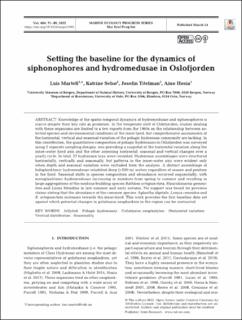| dc.contributor.author | Hernandez, Luis Felipe Martell | |
| dc.contributor.author | Selsø, Katrine | |
| dc.contributor.author | Titelman, Josefin | |
| dc.contributor.author | Hosia, Aino Laila Johanna | |
| dc.date.accessioned | 2022-06-07T11:42:33Z | |
| dc.date.available | 2022-06-07T11:42:33Z | |
| dc.date.created | 2022-04-20T15:15:28Z | |
| dc.date.issued | 2022 | |
| dc.identifier.issn | 0171-8630 | |
| dc.identifier.uri | https://hdl.handle.net/11250/2997705 | |
| dc.description.abstract | Knowledge of the spatio-temporal dynamics of hydromedusae and siphonophores is scarce despite their key role as predators. In the temperate inlet of Oslofjorden, studies dealing with these organisms are limited to a few reports from the 1960s on the relationship between selected species and environmental conditions of the inner fjord, but comprehensive assessments of the horizontal, vertical and seasonal variation of the pelagic hydrozoan community are lacking. In this contribution, the quantitative composition of pelagic hydrozoans in Oslofjorden was surveyed using 2 separate sampling designs: one providing a snapshot of the horizontal variation along the inner-outer fjord axis and the other assessing horizontal, seasonal and vertical changes over a yearly cycle. In total, 27 hydrozoan taxa were recorded. Hydrozoan assemblages were structured horizontally, vertically and seasonally, but patterns in the inner-outer axis were evident only when depth and seasonal variation were excluded from the analysis. A distinct assemblage of holoplanktonic hydromedusae inhabited deep (>100 m) waters regardless of season and position in the fjord. Seasonal shifts in species composition and abundance occurred sequentially, with meroplanktonic hydromedusae increasing in numbers from spring to summer and resulting in large aggregations of the medusa-budding species Rathkea octopunctata, Stauridiosarsia gemmifera and Lizzia blondina in late summer and early autumn. No support was found for previous claims stating that the abundance of the common species Aglantha digitale, Lensia conoidea and R. octopunctata increases towards the inner-fjord. This work provides the first baseline data set against which potential changes in gelatinous zooplankton in the region can be contrasted. | en_US |
| dc.language.iso | eng | en_US |
| dc.publisher | Inter Research | en_US |
| dc.rights | Navngivelse 4.0 Internasjonal | * |
| dc.rights.uri | http://creativecommons.org/licenses/by/4.0/deed.no | * |
| dc.title | Setting the baseline for the dynamics of siphonophores and hydromedusae in Oslofjorden | en_US |
| dc.title.alternative | Setting the baseline for the dynamics of siphonophores and hydromedusae in Oslofjorden | en_US |
| dc.type | Journal article | en_US |
| dc.type | Peer reviewed | en_US |
| dc.description.version | publishedVersion | en_US |
| dc.rights.holder | Copyright The authors 2022 | en_US |
| cristin.ispublished | true | |
| cristin.fulltext | original | |
| cristin.qualitycode | 2 | |
| dc.identifier.doi | 10.3354/meps13991 | |
| dc.identifier.cristin | 2017942 | |
| dc.source.journal | Marine Ecology Progress Series | en_US |
| dc.source.pagenumber | 71-89 | en_US |
| dc.identifier.citation | Marine Ecology Progress Series. 2022, 686, 71-89. | en_US |
| dc.source.volume | 686 | en_US |

